Answered step by step
Verified Expert Solution
Question
1 Approved Answer
Questions imagine you are an OD consultant that has been called to figure out the issues in Namaste Solar. 1. What are the presenting and

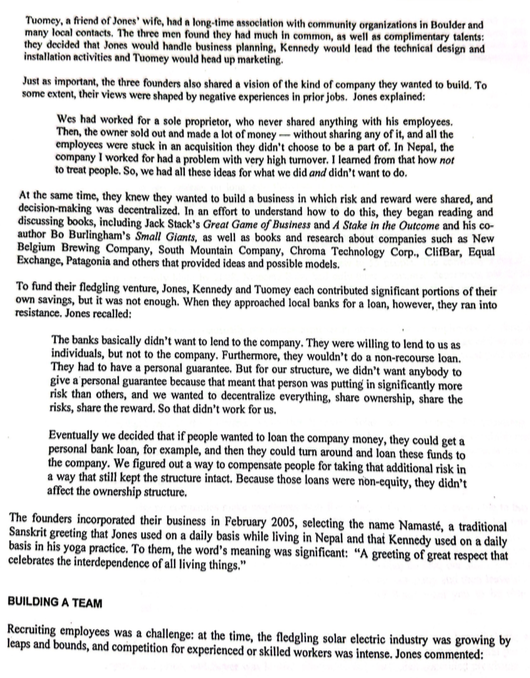
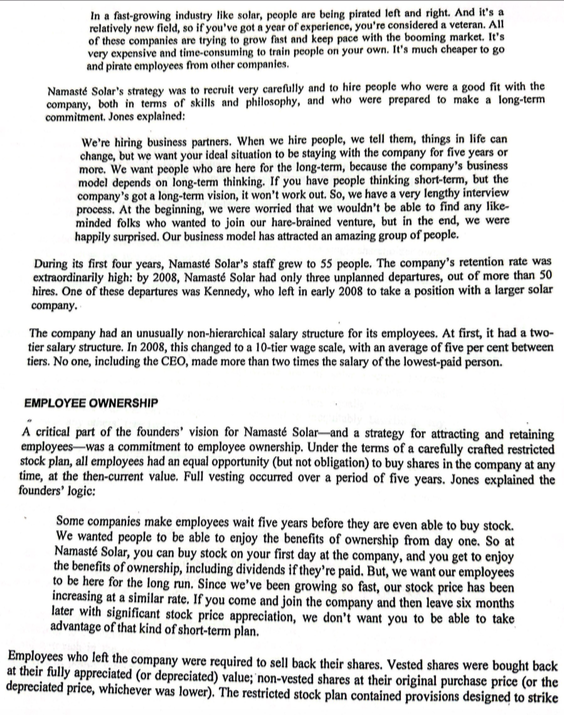
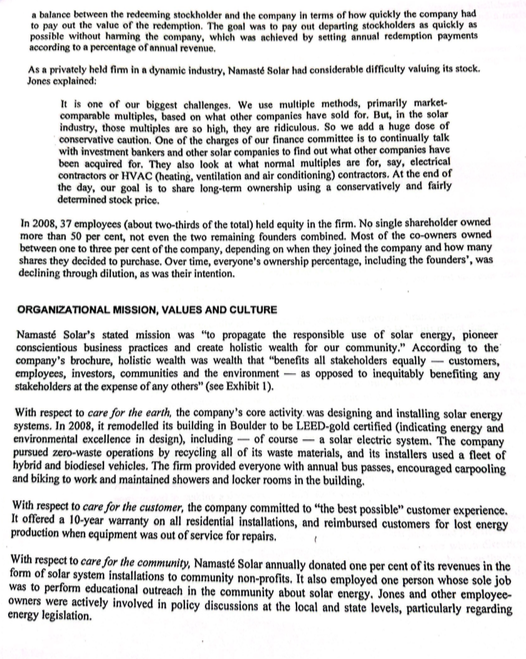
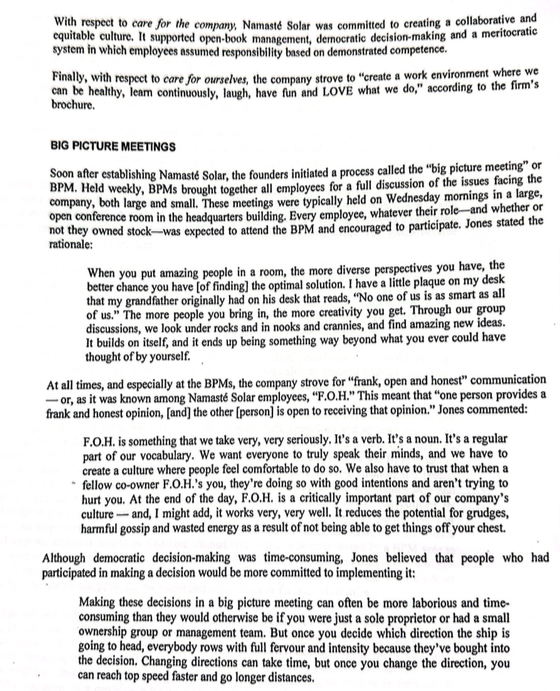
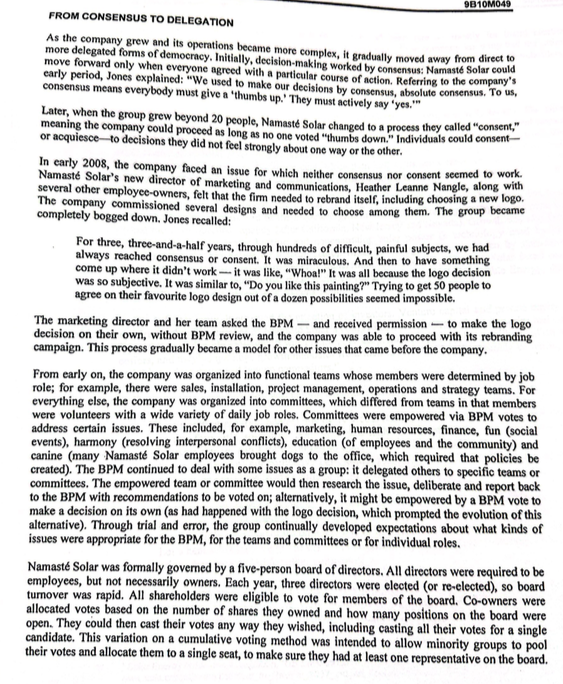
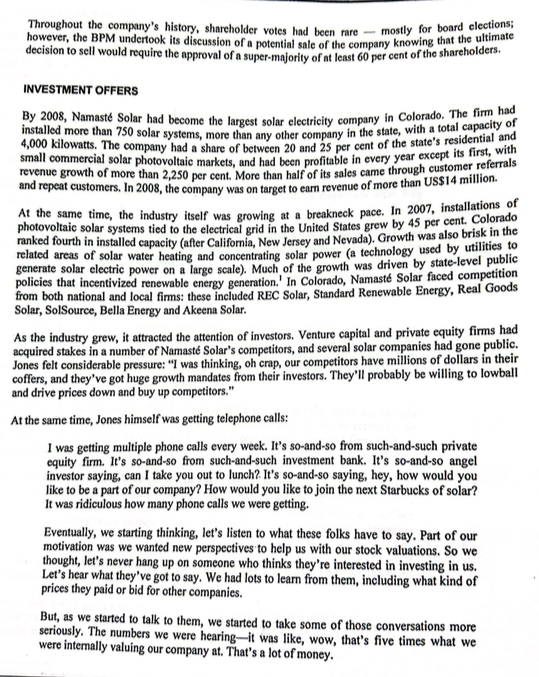


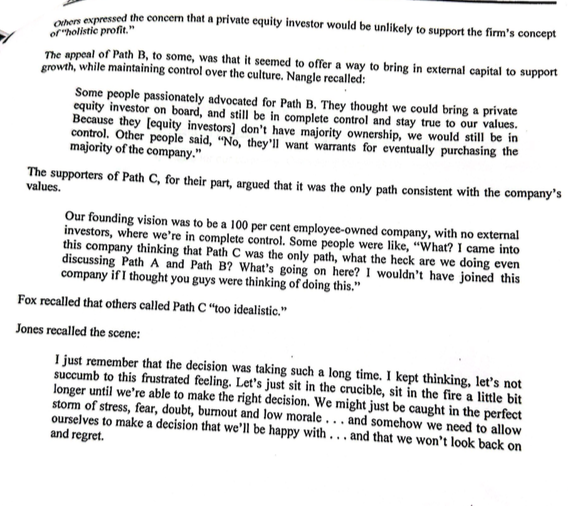
Questions
imagine you are an OD consultant that has been called to figure out the issues in Namaste Solar.
1. What are the presenting and underlying problems?
2. What are the data gathering plans that can be used?
3. What intervention plan would be best selected for this organization?
4. What would be the implementation of the plan for changes?
BLAKE JONES Jones and two partners had founded Namast Solar in late 2004. Jones, then 30 , had trained as a civil engineer. After college, he went to work for the engineering and construction firm Brown \& Root, then a subsidiary of Halliburton, where he worked on many oil and gas projects including a large gas field development project in Egypt. Although he was fascinated by energy and enjoyed working in a developing country, Jones was beginning to have concems about the environmental impact of fossil fuels. He recalled: My older brother was a big influence on me. He was saying, "Hey, you shouldn't be in oil and gas, you should be in renewable energy instead." I hadn't thought much about environmental issues and society's over-dependence on fossil fuels until he started sharing those ideas with me. As I started to see these things for myself, I began to have a gradual awakening that I wanted to get out of oil and gas and into renewable energy. In particular, I wanted to work with renewables in a developing country. Jones left Brown \& Root in 2001 and took a position with a 120-person renewable energy company in Nepal. A small, mountainous country wedged between India and China, Nepal had no fossil fuels; however, it did have a fast-growing demand for electricity and many sources of renewable energy. Jones described the opportunities and challenges he faced there: Nepal was a playground for clean energy technologies, not just solar, but electric vehicles, biogas, hydro, wind and more. You're talking about harsh and remote environments in the hills and mountains where the design and installation has to be perfect. You can't afford to have things break down. We leamed to do things right the first time. Although Jones was happy in Nepal, events converged to draw him back to the United States. While living abroad, Jones had retumed periodically to visit his brother and sister-in-law in Boulder, Colorado. He met and fell in love with a woman there who was not interested in a permanent move to Nepal. Jones laughed: "Colorado was where I wanted to come back to, because that was part of the deal for getting my wife to agree to marry me?" NAMAST SOLAR An opportunity soon presented itself. In November 2004, voters in Colorado passed a ballot initiative that established a renewable electricity standard (RES). The RES required large, investor-owned electric utilities in the state to purchase at least 10 per cent of their supply of electricity by 2015 from renewable sources such as solar, wind, biomass or geothermal. This figure was to rise over time to 20 per cent by 2020. The standard also included a "solar carve-out" that mandated that at least four per cent of the renewable energy come from solar (sun-produced) electricity. Of this, half had to be generated on-site by customers, such as individual homeowners or businesses. The utilities were required to provide whatever incentives were necessary in order to get enough homeowners and business owners to purchase and install solar electric systems. For the first time, the RES created a real economic incentive for the installation of solar systems in newly constructed buildings and retrofits in Colorado. Jones immediately saw an opportunity to apply the skills he had leamed in Nepal - and, at the same time, to follow his heart to Boulder. Back in Colorado, Jones got married and brought in two partners to start a new business. Wes Kennedy, a friend of a friend, had experience in solar installations and was looking for an employment change. Ray Tuomey, a friend of Jones' wife, had a long-time association with community organizations in Boulder and many local contacts. The three men found they had much in common, as well as complimentary talents: they decided that Jones would handle business planning, Kennedy would lead the technical design and installation activities and Tuomey would head up marketing. Just as important, the three founders also shared a vision of the kind of company they wanted to build. To some extent, their views were shaped by negative experiences in prior jobs. Jones explained: Wes had worked for a sole proprietor, who never shared anything with his employees. Then, the owner sold out and made a lot of money - without sharing any of it, and all the employees were stuck in an acquisition they didn't choose to be a part of. In Nepal, the company I worked for had a problem with very high tumover. I leamed from that how not to treat people. So, we had all these ideas for what we did and didn't want to do. At the same time, they knew they wanted to build a business in which risk and reward were shared, and decision-making was decentralized. In an effort to understand how to do this, they began reading and discussing books, including Jack Stack's Great Game of Business and A Stake in the Outcome and his coauthor Bo Burlingham's Small Giants, as well as books and research about companies such as New Belgium Brewing Company, South Mountain Company, Chroma Technology Corp., ClifBar, Equal Exchange, Patagonia and others that provided ideas and possible models. To fund their fledgling venture, Jones, Kennedy and Tuomey each contributed significant portions of their own savings, but it was not enough. When they approached local banks for a loan, however, they ran into resistance. Jones recalled: The banks basically didn't want to lend to the company. They were willing to lend to us as individuals, but not to the company. Furthermore, they wouldn't do a non-recourse loan. They had to have a personal guarantee. But for our structure, we didn't want anybody to give a personal guarantee because that meant that person was putting in significantly more risk than others, and we wanted to decentralize everything, share ownership, share the risks, share the reward. So that didn't work for us. Eventually we decided that if people wanted to loan the company money, they could get a personal bank loan, for example, and then they could turn around and loan these funds to the company. We figured out a way to compensate people for taking that additional risk in a way that still kept the structure intact. Because those loans were non-equity, they didn't affect the ownership structure. The founders incorporated their business in February 2005, selecting the name Namast, a traditional Sanskrit greeting that Jones used on a daily basis while living in Nepal and that Kennedy used on a daily basis in his yoga practice. To them, the word's meaning was significant: "A greeting of great respect that celebrates the interdependence of all living things." BUILDING A TEAM Recruiting employees was a challenge: at the time, the fledgling solar electric industry was growing by leaps and bounds, and competition for experienced or skilled workers was intense. Jones commented: In a fast-growing industry like solar, people are being pirated left and right. And it's a relatively new field, so if you've got a year of experience, you're considered a veteran. All of these companies are trying to grow fast and keep pace with the booming market. It's very expensive and time-consuming to train people on your own. It's much cheaper to go and pirate employees from other companies. Namaste Solar's strategy was to recruit very carefully and to hire people who were a good fit with the company, both in terms of skills and philosophy, and who were prepared to make a long-term commitment. Jones explained: We're hiring business partners. When we hire people, we tell them, things in life can change, but we want your ideal situation to be staying with the company for five years or more. We want people who are here for the long-term, because the company's business model depends on long-term thinking. If you have people thinking short-term, but the company's got a long-term vision, it won't work out. So, we have a very lengthy interview process. At the beginning, we were worried that we wouldn't be able to find any likeminded folks who wanted to join our hare-brained venture, but in the end, we were happily surprised. Our business model has attracted an amazing group of people. During its first four years, Namaste Solar's staff grew to 55 people. The company's retention rate was extraordinarily high: by 2008, Namast Solar had only three unplanned departures, out of more than 50 hires. One of these departures was Kennedy, who left in early 2008 to take a position with a larger solar company. The company had an unusually non-hierarchical salary structure for its employees. At first, it had a twotier salary structure. In 2008, this changed to a 10-tier wage scale, with an average of five per cent between tiers. No one, including the CEO, made more than two times the salary of the lowest-paid person. EMPLOYEE OWNERSHIP A critical part of the founders' vision for Namast Solar-and a strategy for attracting and retaining employees-was a commitment to employee ownership. Under the terms of a carefully crafted restricted stock plan, all employees had an equal opportunity (but not obligation) to buy shares in the company at any time, at the then-current value. Full vesting occurred over a period of five years. Jones explained the founders' logic: Some companies make employees wait five years before they are even able to buy stock. We wanted people to be able to enjoy the benefits of ownership from day one. So at Namast Solar, you can buy stock on your first day at the company, and you get to enjoy the benefits of ownership, including dividends if they're paid. But, we want our employees to be here for the long run. Since we've been growing so fast, our stock price has been increasing at a similar rate. If you come and join the company and then leave six months later with significant stock price appreciation, we don't want you to be able to take advantage of that kind of short-term plan. Employees who left the company were required to sell back their shares. Vested shares were bought back t their fully appreciated (or depreciated) value; non-vested shares at their original purchase price (or the lepreciated price, whichever was lower). The restricted stock plan contained provisions designed to strike a balance between the redeeming stockholder and the company in terms of how quickly the company had to pay out the value of the redemption. The goal was to pay out departing stockholders as quickly as possible without harming the company, which was achieved by setting annual redemption payments according to a percentage of annual revenue. As a privately held firm in a dynamic industry, Namaste Solar had considerable difficulty valuing its stock. Jones explained: It is one of our biggest challenges. We use multiple methods, primarily marketcomparable multiples, based on what other companies have sold for. But, in the solar industry, those multiples are so high, they are ridiculous. So we add a huge dose of conservative caution. One of the charges of our finance committee is to continually talk with investment bankers and other solar companies to find out what other companies have been acquired for. They also look at what normal multiples are for, say, electrical contractors or HVAC (heating, ventilation and air conditioning) contractors. At the end of the day, our goal is to share long-term ownership using a conservatively and fairly determined stock price. In 2008, 37 employees (about two-thirds of the total) held equity in the firm. No single shareholder owned more than 50 per cent, not even the two remaining founders combined. Most of the co-owners owned between one to three per cent of the company, depending on when they joined the company and how many shares they decided to purchase. Over time, everyone's ownership percentage, including the founders', was declining through dilution, as was their intention. ORGANIZATIONAL MISSION, VALUES AND CULTURE Namast Solar's stated mission was "to propagate the responsible use of solar energy, pioneer conscientious business practices and create holistic wealth for our community," According to the company's brochure, holistic wealth was wealth that "benefits all stakeholders equally - customers, employees, investors, communities and the environment - as opposed to inequitably benefiting any stakeholders at the expense of any others" (see Exhibit 1). With respect to care for the earth, the company's core activity. was designing and installing solar energy systems. In 2008, it remodelled its building in Boulder to be LEED-gold certified (indicating energy and environmental excellence in design), including - of course - a solar electric system. The company pursued zero-waste operations by recycling all of its waste materials, and its installers used a fleet of hybrid and biodiesel vehicles. The firm provided everyone with annual bus passes, encouraged carpooling and biking to work and maintained showers and locker rooms in the building. With respect to care for the customer, the company committed to "the best possible" customer experience. It offered a 10-year warranty on all residential installations, and reimbursed customers for lost energy production when equipment was out of service for repairs. With respect to care for the community, Namast Solar annually donated one per cent of its revenues in the form of solar system installations to community non-profits. It also employed one person whose sole job was to perform educational outreach in the community about solar energy. Jones and other employeeowners were actively involved in policy discussions at the local and state levels, particularly regarding energy legislation. With respect to care for the company, Namaste Solar was committed to creating a collaborative and equitable culture. It supported open-book management, democratic decision-making and a meritocratic system in which employees assumed responsibility based on demonstrated competence. Finally, with respect to care for ourselves, the company strove to "create a work environment where we can be healthy, leam continuously, laugh, have fun and LOVE what we do," according to the firm's brochure. BIG PICTURE MEETINGS Soon after establishing Namaste Solar, the founders initiated a process called the "big picture meeting" or BPM. Held weekly, BPMs brought together all employees for a full discussion of the issues facing the company, both large and small. These meetings were typically held on Wednesday mornings in a large, open conference room in the headquarters building. Every employee, whatever their role-and whether or not they owned stock-was expected to attend the BPM and encouraged to participate. Jones stated the rationale: When you put amazing people in a room, the more diverse perspectives you have, the better chance you have [of finding] the optimal solution. I have a little plaque on my desk that my grandfather originally had on his desk that reads, "No one of us is as smart as all of us." The more people you bring in, the more creativity you get. Through our group discussions, we look under rocks and in nooks and crannies, and find amazing new ideas. It builds on itself, and it ends up being something way beyond what you ever could have thought of by yourself. At all times, and especially at the BPMs, the company strove for "frank, open and honest" communication - or, as it was known among Namast Solar employees, "F.O.H." This meant that "one person provides a frank and honest opinion, [and] the other [person] is open to receiving that opinion." Jones commented: F.O.H. is something that we take very, very seriously. It's a verb. It's a noun. It's a regular part of our vocabulary. We want everyone to truly speak their minds, and we have to create a culture where people feel comfortable to do so. We also have to trust that when a - fellow co-owner F.O.H.'s you, they're doing so with good intentions and aren't trying to hurt you. At the end of the day, F.O.H. is a critically important part of our company's culture - and, I might add, it works very, very well. It reduces the potential for grudges, harmful gossip and wasted energy as a result of not being able to get things off your chest. Although democratic decision-making was time-consuming, Jones believed that people who had participated in making a decision would be more committed to implementing it: Making these decisions in a big picture meeting can often be more laborious and timeconsuming than they would otherwise be if you were just a sole proprietor or had a small ownership group or management team. But once you decide which direction the ship is going to head, everybody rows with full fervour and intensity because they've bought into the decision. Changing directions can take time, but once you change the direction, you can reach top speed faster and go longer distances. FROM CONSENSUS TO DELEGATION As the company grew and its operations became more complex, it gradually moved away from direct to more delegated forms of democracy. Initially, decision-making worked by consensus: Namaste Solar could move forward only when everyone agreed with a particular course of action. Referring to the company's consensus means everybody mus "We used to make our decisions by consensus, absolute consensus. To us, tive a 'thumbs up.' They must actively say 'yes.'" meaning the company grew beyond 20 people, Namaste Solar changed to a process they ealled "consent," or acquiesce-to decisions they did not fong as no one voted "thumbs down." Individuals could consentthe not feel strongly about one way or the other. In early 2008, the company faced an issue for which neither consensus nor consent seemed to work. several other erar's new director of marketing and communications, Heather Leanne Nangle, along with The company cotoyee-owners, felt that the firm needed to rebrand itself, including choosing a new logo. completely bogged commissioned several designs and needed to choose among them. The group became For three, three-and-a-half years, through hundreds of difficult, painful subjects, we had always reached consensus or consent. It was miraculous. And then to have something come up where it didn't work - it was like, "Whoa!" It was all because the logo decision was so subjective. It was similar to, "Do you like this painting?" Trying to get 50 people to agree on their favourite logo design out of a dozen possibilities seemed impossible. The marketing director and her team asked the BPM - and received permission - to make the logo decision on their own, without BPM review, and the company was able to proceed with its rebranding campaign. This process gradually became a model for other issues that came before the company. From early on, the company was organized into functional teams whose members were determined by job role; for example, there were sales, installation, project management, operations and strategy teams. For everything else, the company was organized into committees, which differed from teams in that members were volunteers with a wide variety of daily job roles. Committees were empowered via BPM votes to address certain issues. These included, for example, marketing, human resources, finance, fun (social events), harmony (resolving interpersonal conflicts), education (of employees and the community) and canine (many Namast Solar employees brought dogs to the office, which required that policies be created). The BPM continued to deal with some issues as a group: it delegated others to specific teams or committees. The empowered team or committee would then research the issue, deliberate and report back to the BPM with recommendations to be voted on; alternatively, it might be empowered by a BPM vote to make a decision on its own (as had happened with the logo decision, which prompted the evolution of this alternative). Through trial and error, the group continually developed expectations about what kinds of issues were appropriate for the BPM, for the teams and committees or for individual roles. Namast Solar was formally governed by a five-person board of directors. All directors were required to be employees, but not necessarily owners. Each year, three directors were elected (or re-elected), so board tumover was rapid. All shareholders were eligible to vote for members of the board. Co-owners were allocated votes based on the number of shares they owned and how many positions on the board were open. They could then cast their votes any way they wished, including casting all their votes for a single candidate. This variation on a cumulative voting method was intended to allow minority groups to pool their votes and allocate them to a single seat, to make sure they had at least one representative on the board. Throughout the company's history, shareholder votes had been rare - mostly for board elections; however, the BPM undertook its discussion of a potential sale of the company knowing that the ultimate decision to sell would require the approval of a super-majority of at least 60 per cent of the shareholders. INVESTMENT OFFERS By 2008, Namast Solar had become the largest solar electricity company in Colorado. The firm had installed more than 750 solar systems, more than any other company in the state, with a total capacity of 4,000 kilowatts. The company had a share of between 20 and 25 per cent of the state's residential and small commercial solar photovoltaic markets, and had been profitable in every year except its first, with revenue growth of more than 2,250 per cent. More than half of its sales came through customer referrals and repeat customers. In 2008, the company was on target to eam revenue of more than US $14 million. At the same time, the industry itself was growing at a breakneck pace. In 2007, installations of photovoltaic solar systems tied to the electrical grid in the United States grew by 45 per cent. Colorado ranked fourth in installed capacity (after Califormia, New Jersey and Nevada). Growth was also brisk in the related areas of solar water heating and concentrating solar power (a technology used by utilities to generate solar electric power on a large scale). Much of the growth was driven by state-level public policies that incentivized renewable energy generation.' In Colorado, Namast Solar faced competition from both national and local firms: these included REC Solar, Standard Renewable Energy, Real Goods Solar, SolSource, Bella Energy and Akeena Solar. As the industry grew, it attracted the attention of investors. Venture capital and private equity firms had acquired stakes in a number of Namaste Solar's competitors, and several solar companies had gone public. Jones felt considerable pressure: "I was thinking, oh crap, our competitors have millions of dollars in their coffers, and they've got huge growth mandates from their investors. They'll probably be willing to lowball and drive prices down and buy up competitors." At the same time, Jones himself was getting telephone calls: I was getting multiple phone calls every week. It's so-and-so from such-and-such private equity firm. It's so-and-so from such-and-such investment bank. It's so-and-so angel investor saying, can I take you out to lunch? It's so-and-so saying, hey, how would you like to be a part of our company? How would you like to join the next Starbucks of solar? It was ridiculous how many phone calls we were getting. Eventually, we starting thinking, let's listen to what these folks have to say. Part of our motivation was we wanted new perspectives to help us with our stock valuations. So we thought, let's never hang up on someone who thinks they're interested in investing in us. Let's hear what they've got to say. We had lots to learn from them, including what kind of prices they paid or bid for other companies. But, as we started to talk to them, we started to take some of those conversations more seriously. The numbers we were hearing-it was like, wow, that's five times what we were intemally valuing our company at. That's a lot of money. At the same time, we were all exhausted from multiple years of non-stop, break-neck growth. At this particular time, we were going through an intense turn on our ongoing roller coaster ride and many of us were approaching bumout and overload. We all had our life savings in the company and were feeling more scared than normal that summer about the financial risks we were all taking. Our only exit strategy was to sell internally, but we didn't know if that would work. So the end seemed nowhere in sight and we kept having to double-down on our bets. Last but not least, one of our founders had just left the company. Wes, who everyone looked up to as a founder and a steward of our company vision, had just decided to leave the company, which came as a surprise to all of us. So, you combine all of this together and we were in a very vulnerable place from a morale perspective. As Jones began fielding inquiries, he shared them immediately in the BPM, so employees were fully briefed on these conversations. In mid-2008, two particular firms emerged as serious bidders. Jones considered both entities the best candidates among all of the rest, and they were both offering a range of opportunities from a sale of a minority equity stake all the way to a complete acquisition. "SITTING IN THE CRUCIBLE"2 Over the course of the next two months, the company held a series of Wednesday morning mini-retreats to consider these two offers, and had narrowed its possible response to three options. Now, sitting in thriftshop chairs and couches in the mid-summer heat, the group felt it needed to move to some closure. Both firms wanted to take the next steps, and the company perceived their window of opportunity to be limited in duration. Path A was, in Jones' words, to "sell the whole kit and caboodle." Path B was a hybrid, involving the sale of a portion of the company, with employees retaining partial ownership. Path C was to recommit to Namast Solar's original vision of being a privately held, 100 per cent employee-owned firm, with or without some changes in strategy. The discussion of the pros and cons of the three paths was frank and wide-ranging. Path A and Path B would both bring a fresh infusion of capital into the company. The company had been growing faster than t was able to generate capital intemally, and found it difficult to obtain non-recourse bank loans. "We were growing so fast, we kept needing more moncy. Where's the money going to come from? lnvestors could supply that." Ohers agreed, saying the company needed to grow at least as fast as the market, and that they could not do o without accepting external capital. We were worried that it was against the natural laws of business. Is it true that "you're either growing or you're dying?" If your market is growing 100 per cent a year, and you're only growing at 10 per cent a year, is that sustainable? It was the fear of big fish gobbling up the small fish. People said we're going to get clobbered unless we do something. We'd better take on some money. We'd better keep growing. We'd better keep the triple-digit percentage growth every year. Selling the company appealed to some who wanted to spread the "gospel" of solar power as widely as possible. Additional capital would enable the firm to hire more people, reach more customers and install more solar panels. Nangle, Namaste Solar's director of marketing and communications, later recalled this view: "Some people work here because they want to propagate solar as much as possible and therefore have a greater global effect. It's all about impact. Some people said, think of all the solar we could do all over the world." Chris Fox, an installer, recalled, "There was this sense that bringing in investor capital was necessary at the time. Some people were very persuasive, saying we have a great opportunity in this fast-growing market. Let's talk about trying to maximize our profit and our growth curve in order to reap the benefits of that." For some employeo-owners who were vested or close to vested, the matter was more personal: the offers provided an opportunity for a handsome retum on their investment in the company. "[To some people], the offers were tempting. As much as we like to say "it's not about the money," when you get a stack of hundreds slapped in your face, you're kind of like, "hmm, yeah, that's a lot of money." The numbers we were looking at were five times what we were valuing the company at internally." Another personal factor was bumout. Many of the employees sitting around the warehouse that day felt tired and overworked. The buyout offered a chance to take the money and move on to a less stressful job. That summer was really hard. We had had triple-digit growth for several years in a row. We had just opened a new office in Denver, the building here in Boulder was being renovated, and we were all spread out. It was crazy. People felt really burned out, against the ropes. Their idea seemed to be that if we sold the company, we wouldn't have everybody's life savings on the line. We could take our chips off the table, and we wouldn't have to be on the hook anymore. On the other hand, many expressed grave reservations about the impact of an acquisition on Namast Solar's carefully crafted culture. "There was the problem of complete loss of control. Culture was just out the window with Path A, unless we felt we could really trust [the acquiring company]. What do we think it's going to be like to work for this company? Are they going to respect our culture? No one has the same values as we do." Nangle pointed out: 'I'm passionate about our grant program. We have an incredible grant program where we give one per cent of revenue, regardless of our profit, to the community. To me, that makes us one of the coolest companies on the planet, let alone in Colorado. I felt a private investor would say, "What the heck are you doing that for? Stop that. Don't give your money away.". She also expressed concern about a possible loss of the family feeling at the company: I was a strong voice for wanting to keep the family quality that we have. I want to be able to sit in a big picture meeting and know every single person there. I don't need to know every detail, but I want to be able to sit next to someone and ask, "how's your child... how's this or that?" If I'm sitting in a room with 500 people, there's no way you're going to know me, or I'm going to know you. The family element would be lost. Odhers expressed the concern that a private equity investor would be unlikely to support the firm's concep The appeal of Path B, to some, was that it seemed to offer a way to bring in external capital to suppor growth, while maintaining control over the culture. Nangle recalled: Some people passionately advocated for Path B. They thought we could bring a private equity investor on board, and still be in complete control and stay true to our values. Because they [equity investors] don't have majority ownership, we would still be in majority of the company." "No, they'll want warrants for eventually purchasing the The supporters of Path C, for their part, argued that it was the only path consistent with the company values. Our founding vision was to be a 100 per cent employee-owned company, with no external investors, where we're in complete control. Some people were like, "What? I came into this company thinking that Path C was the only path, what the heck are we doing even discussing Path A and Path B? What's going on here? I wouldn't have joined this company if I thought you guys were thinking of doing this." Fox recalled that others called Path C "too idealistic." ones recalled the scene: I just remember that the decision was taking such a long time. I kept thinking, let's not succumb to this frustrated feeling. Let's just sit in the crucible, sit in the fire a little bit longer until we're able to make the right decision. We might just be caught in the perfect storm of stress, fear, doubt, bumout and low morale ... and somehow we need to allow ourselves to make a decision that we'll be happy with. ... and that we won't look back onStep by Step Solution
There are 3 Steps involved in it
Step: 1

Get Instant Access to Expert-Tailored Solutions
See step-by-step solutions with expert insights and AI powered tools for academic success
Step: 2

Step: 3

Ace Your Homework with AI
Get the answers you need in no time with our AI-driven, step-by-step assistance
Get Started


